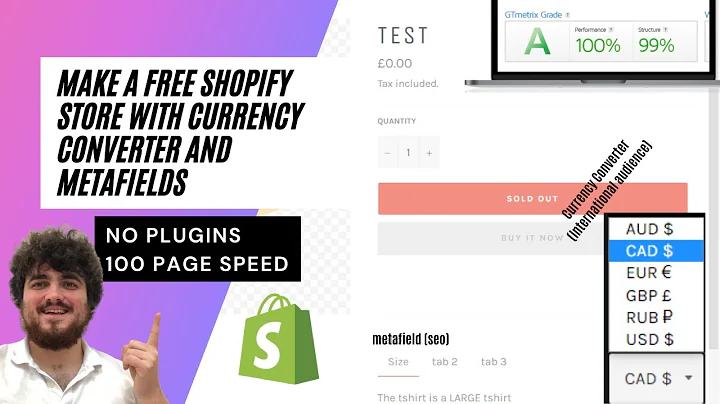Boost Your eCommerce Product Page with SEO Optimization
Table of Contents:
- Introduction
- Understanding On-Page Optimization
- Importance of Target Keywords
- Optimizing the Product Title
- Incorporating Target Keywords in the Content
- Using H2 and H3 Headings
- Adding Target Keywords in the Image Alt Text
- Customizing SEO Title and Meta Description
- Including Target Keywords in the URL
- Balancing Optimization and Over-Optimization
- Conclusion
Understanding On-Page Optimization for eCommerce Product Pages
When it comes to getting your eCommerce products to show up on Google for specific keywords, on-page optimization plays a crucial role. By optimizing your product pages, you provide Google with context clues about the main idea of your page, ultimately increasing your chances of ranking higher in search results. In this article, we will dive into the different aspects of on-page optimization for eCommerce product pages, focusing on optimizing target keywords effectively.
Introduction
Are you looking for ways to get your eCommerce products to show up on Google for specific keywords? If so, you've come to the right place. In this article, we will explore the concept of on-page optimization for product pages and how it can help improve your visibility on search engines. Whether you're a beginner or have some knowledge of SEO, we'll break it down into simple steps to ensure that you can optimize your product pages and increase your chances of ranking higher in search results. So, let's get started!
Understanding On-Page Optimization
Before diving into on-page optimization for product pages, it's essential to understand its significance. On-page optimization refers to the process of optimizing specific elements within a webpage to improve its visibility on search engine result pages (SERPs). When applied to product pages, on-page optimization involves optimizing elements such as product titles, content, headings, image alt text, URL, and metadata.
Importance of Target Keywords
The cornerstone of effective on-page optimization is identifying and incorporating target keywords. A target keyword is a specific word or phrase that accurately represents the main idea of your product page. By optimizing your product pages for target keywords, you provide search engines like Google with a clear understanding of what your page is about. This, in turn, increases the likelihood of your page appearing in search results when users search for relevant keywords.
Optimizing the Product Title
One of the most critical places to include your target keyword is in the product title itself. The product title is displayed prominently on the product page and holds significant weight in terms of SEO. By placing your target keyword in the product title, you provide Google with a clear indication of the page's main idea. Be sure to keep the title concise, informative, and engaging while incorporating the target keyword naturally.
Incorporating Target Keywords in the Content
Another essential aspect of on-page optimization is integrating target keywords within the content of the product page. Ideally, your target keyword should appear within the first two paragraphs or the first 250 words of the content. It is crucial to avoid keyword stuffing and maintain a natural flow of the content. Over-optimizing the content may not only harm your SEO efforts but also discourage potential customers from making a purchase.
Using H2 and H3 Headings
To further optimize your product page, consider using H2 or H3 headings that include your target keyword. By incorporating the keyword within heading tags, you provide additional context to search engines and improve the readability of your page. For product pages, using headings like "Product Details" followed by the target keyword and relevant details can help both search engines and users understand the purpose and features of the product.
Adding Target Keywords in the Image Alt Text
Images are an integral part of eCommerce product pages, and optimizing their alt text is crucial for on-page optimization. Alt text is used to describe images to search engines since they cannot "see" images directly. By including your target keyword in the alt text of the main product image, you provide search engines with valuable context about the image and its relevance to the target keyword. Remember to keep the alt text concise, accurate, and natural-sounding.
Customizing SEO Title and Meta Description
To enhance your product page's visibility in search results, customize the SEO title and meta description. The SEO title appears as the clickable headline in search results, while the meta description provides users with a brief summary of the page's content. Including your target keyword in the SEO title and meta description can help search engines associate your page with relevant search queries. However, be mindful of character limits and ensure that the wording sounds natural and enticing to users.
Including Target Keywords in the URL
Optimizing the URL of your product page is an often overlooked aspect of on-page optimization. By incorporating your target keyword in the URL, you provide search engines with another indicator of the page's main idea. Use dashes to separate words in the URL, as search engines treat dashes as spaces. Avoid using underscores or other characters that may appear spammy.
Balancing Optimization and Over-Optimization
When optimizing your product pages, it's essential to strike a balance between optimizing for target keywords and avoiding over-optimization. Over-optimization refers to excessive and unnatural use of target keywords, which can negatively impact your SEO efforts and user experience. Ensure that your content reads naturally and avoids repetitive keyword usage. Remember that the main goal of a product page is to convert visitors into customers, so prioritize providing valuable information over keyword density.
Conclusion
By implementing on-page optimization techniques, you can significantly enhance the visibility of your eCommerce product pages on search engines. Remember to conduct thorough keyword research, craft compelling content, and optimize key elements such as the product title, content, headings, alt text, URL, SEO title, and meta description. Striking a balance between optimization and user experience is crucial for driving organic traffic and increasing conversions. Start optimizing your product pages today and watch your rankings improve.






















